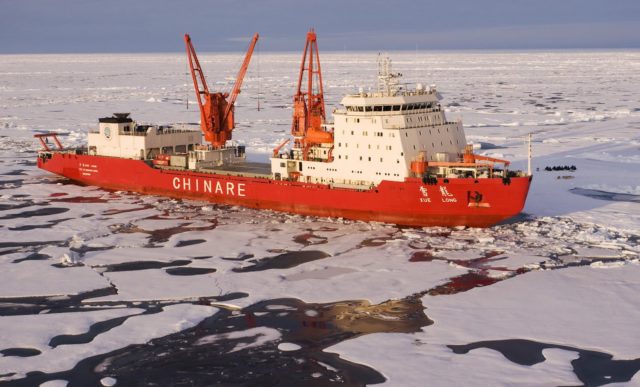
Moscow Worried About Chinese Dominance of Northern Sea Route
Publication: Eurasia Daily Monitor Volume: 16 Issue: 117
By:

For years, Moscow had expected that it could dominate the Northern Sea Route and access to the rich natural resources on the Arctic seabed by virtue of its geographic position and its possession of the largest fleet of icebreakers in the world—assets that are absolutely necessary to operate in the High North. Yet, climate change, the collapse of the Russian domestic shipbuilding industry as well as increased interest by other powers—most prominently, China—has called into question Moscow’s assumptions and sparked fears in the Russian capital about what Beijing is doing. These developments have even led some Russian analysts to express hope that the United States’ concerns about Chinese activities in the Arctic may help Moscow restrain or contain China’s penetration of what many Russians, including President Vladimir Putin, believe is Russia’s backyard.
Global warming has undercut Moscow’s position of strength in the High North. As long as the Northern Sea Route, which follows Russia’s northern coast, was covered with ice most of the year and required icebreakers to accompany ships wanting to pass along it, Moscow could reasonably expect to control the situation. Additionally, as long as most of the sought-after resources in the Arctic were beneath the icecap, Russia’s position again seemed unassailable. This year, however, with the Arctic featuring the highest temperatures on record, the Northern Sea Route has been ice free for longer than ever before in modern history, reducing Russia’s importance. The ice cap is also now smaller than it has ever been at any recent time, allowing others to gain access to the region’s mineral wealth.
At the same time, Russia’s position is fading for two other reasons, one largely domestic and the other foreign. Domestically, it has become obvious that Moscow has no chance of achieving Putin’s ambitious plans for the expansion of the Northern Sea Route over the next decade, especially at a time of significant economic sanctions. It cannot generate or attract the investment it needs (Mnr.gov.ru, March 13; The Barents Observer, March 18); it lacks the infrastructure along the route and has little prospect of building all that would be required (see EDM, December 6, 2018); and it has seen its shipbuilding capacity decline significantly over the last five years (Dcenter.hse.ru, 2018, accessed September 3, 2019).
The biggest challenge to Moscow’s hopes and expectations, however, comes from abroad—specifically, from the increasing interest of other countries in the Arctic more generally and in the Northern Sea Route in particular. Despite the fact that it does not border the Arctic region, China has signaled for some time that it intends to be a player there (see EDM, July 12, 2018). And it has now taken sufficient steps to realize this, including building its own icebreakers as well as establishing polar research centers at home and abroad. China has even discussed sending its ships not only across the north of Russia to Europe but also dispatching them up Russian rivers flowing into the Arctic to export Russian grain for its population (Omskportal.ru, July 29; The Barents Observer, July 31).
All this Chinese activity is making Moscow nervous, sufficiently so that at least some in the Russian capital hope that US concerns about Beijing’s expansion in the Arctic will help the Russian Federation resist what China is doing. An indication of just how concerned the Kremlin has become is outlined in a new article by Vladimir Ivanov, the chief observer of Moscow’s influential and well-connected Nezavisimoye Voyennoye Obozreniye (Nezavisimoye VoyennoyeObozreniye, August 9).
Ivanov writes that it has now become obvious global warming has changed the game in the Arctic and has attracted the economic and security attention of many countries that had ignored it earlier. The most immediate of these is China. Although the US is increasingly concerned, this is largely in response to what Beijing has been doing. China does not border the Arctic—its land is “more than 1,500 kilometers away,” Ivanov notes. Furthermore, it is not a member of the Arctic Council, although it became an observer there six years ago. Even so, it is acting like an Arctic power, building icebreakers—including nuclear-powered ones—and outlining a strategy that some in Moscow see directed against Russia.
Vladimir Putin has repeatedly talked about integrating China’s Belt and Road Initiative (BRI) transportation plan with Russia’s Northern Sea Route. But Beijing, both in its January 2018 Arctic policy paper and in recent statements by senior officials, has stressed that the Arctic is not for any one country to control and that its maritime routes should be open to all and governed by existing international agreements. From Russia’s point of view, that is a direct challenge to Moscow’s claims and aspirations in the Arctic, including economic exclusion zone demandscovering much of the Arctic seabed. Indeed, Beijing’s position could threaten the progress Moscow has already made in marshalling international recognition of its claims (Windowoneurasia2.blogspot.com, April 5).
At present, Moscow is not in a good position to challenge China on this point because it needs Beijing to counter the West on other issues (see EDM, July 30). Even so, there may be a ray of hope for Moscow from an unexpected source, the Nezavisimoye Voyennye Obozreniye observer says: Washington is also worried about Chinese moves in the Arctic, albeit for its own economic and security reasons. If the US does oppose Chinese aspirations in the Far North, such efforts could limit the damage Beijing is already inflicting on Moscow’s desire to be the dominant player on the Northern Sea Route and over access to minerals on the Arctic seabed (Nezavisimoye Voyennoye Obozreniye, August 9).



